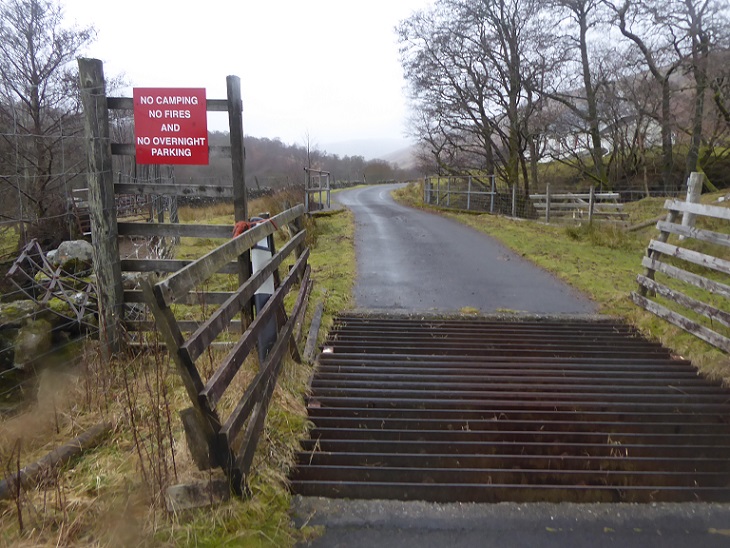
On Xmas Day I took advantage of the relaxation of advice on travelling to head up to Breadalbane for a walk over Maol Ghaordie with my partner. The bog was nicely frozen on the way up, it felt properly wintry on the top and we traversed the hill to descend by the scenic and rarely visited Ghaordaidh burn. We saw just two people when walking back along the road in Glen Lochay.
All perfectly safe. But it is completely unfair that, had we had tried the same walk the day before or after, we could have risked being charged with breaking the law, on the grounds that we did not have a reasonable excuse for travelling 5 miles beyond Glasgow, whereas someone from Perth could have driven out to do the same walk quite legally.
Signs such as the above have littered Glen Lochay since before the Land Reform Act. Perth and Kinross Council, the Access Authority responsible, have now failed to take effective action to remove them for almost twenty years.
Loch Lubnaig
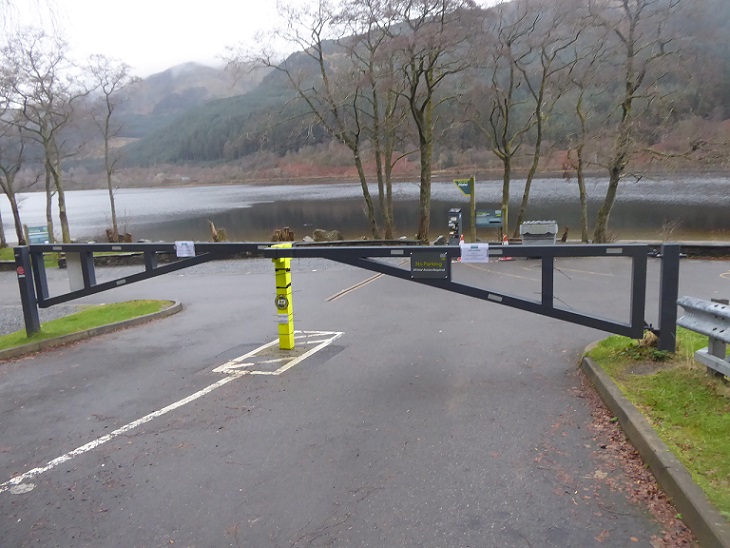
On the way back we stopped at the Cabin at Loch Lubnaig to take a photo of the locked gates which I had noted on the way out. The land, building and car park is owned by the Loch Lomond and Trossachs National Park Authority but, according to information provided to their Board Meeting in December 2018 (see here), has been leased to the Cabin Food Company Ltd until 2038 and they are responsible for managing it. The sign on the gate linked to their website (see here) which explains the current situation:
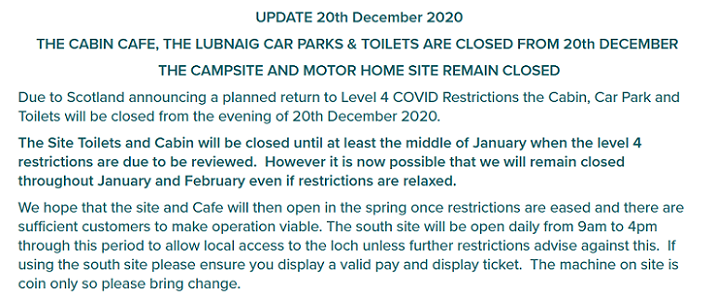
Note the comment that the site will re-open once there are sufficient visitors to make it viable.
I have met the people who run the Cabin, they are lovely and deeply caring. The closure of the car park, a public asset, is not their fault. Rather the problem lies in the way the LLTNPA has offloaded responsibility for managing the land it owns onto others through outsourcing. That can only work if the people managing the facility can raise an income from it. Like lots of other facilities that support tourism and outdoor recreation across Scotland, that income has dried up because of the Covid restrictions. No-one should expect the Cabin or other small businesses to manage such facilities for free
But couldn’t the Cabin just leave the gate open and allow people who live in the Stirling Council area to park here and enjoy the loch? My suspicion is that the terms of the lease preclude this by including requirements that the Cabin Food Company keeps the site clean at all times and safeguards the building the LLTNPA owns from vandalism. Without staff on site, that would create huge risks for the Company’s Directors if they were to keep the gates open. Far simpler just to lock them.
In these circumstances the LLTNPA, who have a statutory duty to support public enjoyment of the countryside, should have stepped in, picked up the pieces and temporarily taken back responsibility for managing the land they own on behalf of the public. That, however, would have cost money.
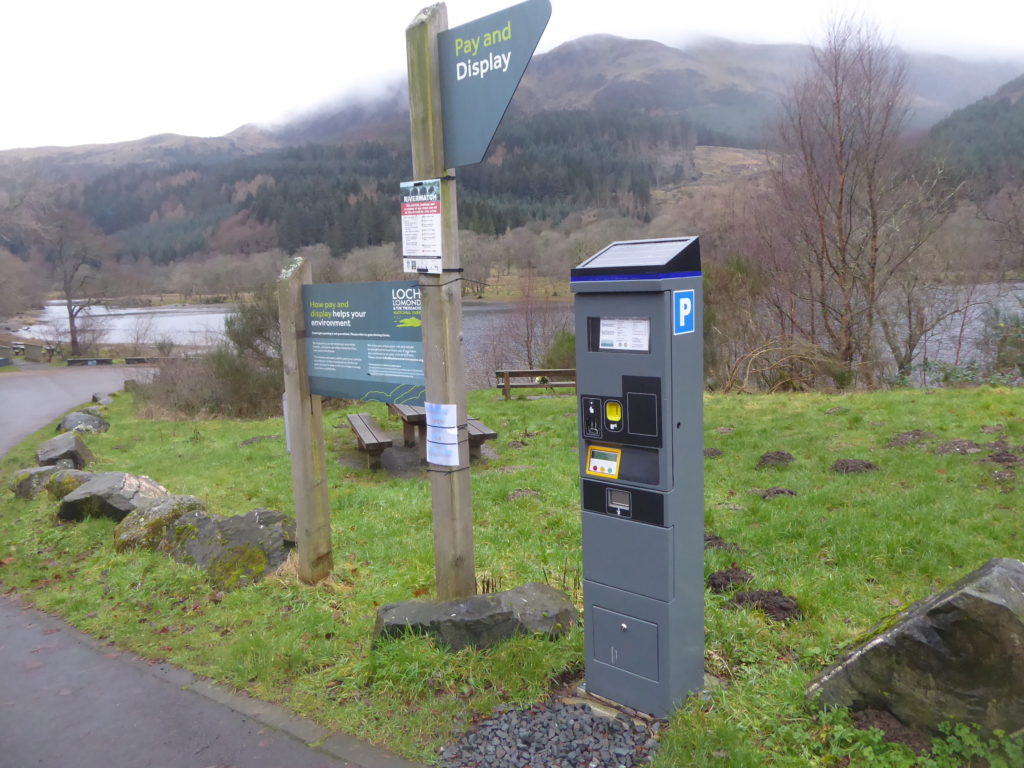
At least the Loch Lubnaig south car park, a mile down the road is still open, supporting the idea that the north car park has been closed because the Cabin would be responsible for making good any vandalism. I don’t know if the Cabin receive the income from the suburban looking pay and display machine. The Park notice board behind says “Pay and Display helps your environment”. Apart from the suburban clutter, the irony of the polluting plastic tree tubes which litter the area around the car park seems to have escaped park officials:
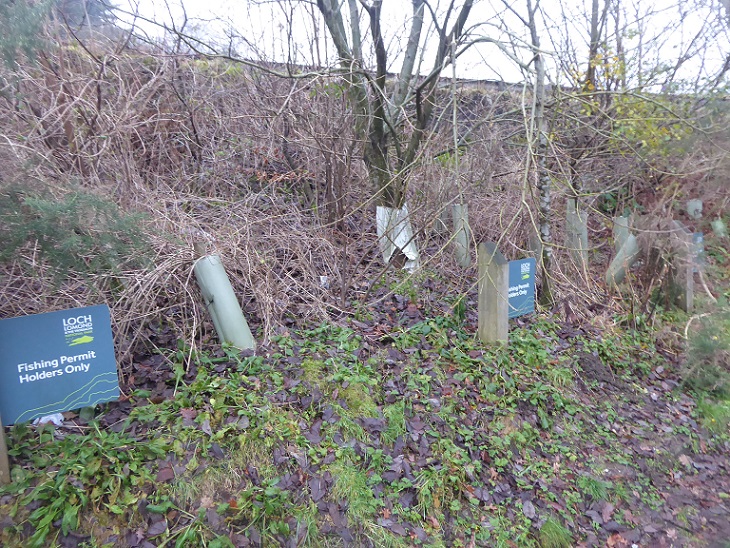
Perhaps the LLTNPA Board could take a resolution this year not to use plastic tree tubes on its land and to pay for the removal of those that are there?
Rowardennan
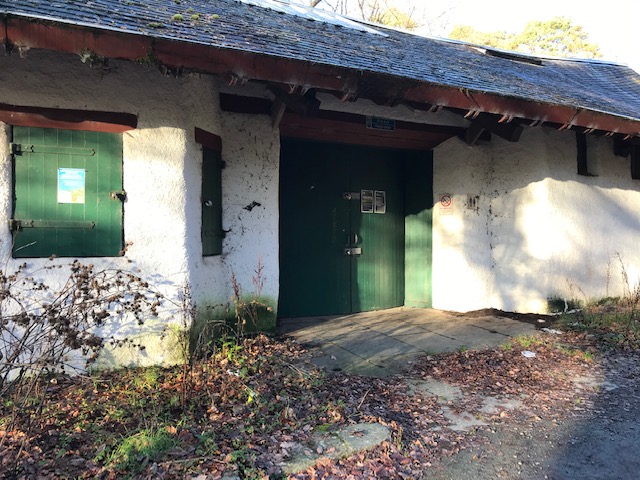
Shortly after New Year I was sent photos of the toilets at Rowardennan by someone who had walked up Ben Lomond on Xmas Eve. There were apparently 60 – 80 cars in the Forestry and Land Scotland’s pay and display car park, all perfectly legal for anyone living in the Stirling Council area, but the toilets, owned by the LLTNPA, were closed – as they have been every winter.
I have remarked before that it is disgraceful that one of Scotland’s most popular hills, known across the world, has no toilet facilities for much of the year. I have written to the LLTNPA asking they be kept open, only to be fobbed off. And if this year the LLTNPA maintain it would unsafe to open the toilets because of Covid-19, the question is why they didn’t leave the mobile toilets in place, as I proposed to their Board back in September (see here)?
The LLTNPA should be held responsible for all the human waste that mars the area around Rowardennan and also for deterring visitors through their failure to provide adequate infrastructure.
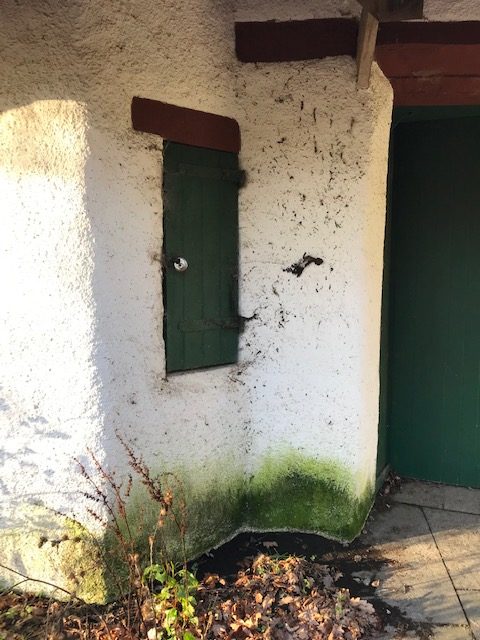
What was striking from the photos, however, is the extent to which the LLTNPA has been failing to maintain what is a public asset and has allowed the toilet block to fall into a state of disrepair. It wouldn’t take much for the LLTNPA to make the block appear cared for but instead they appear to have abandoned it. It’s a fairly safe bet that if this continues, graffiti and vandalism will follow.
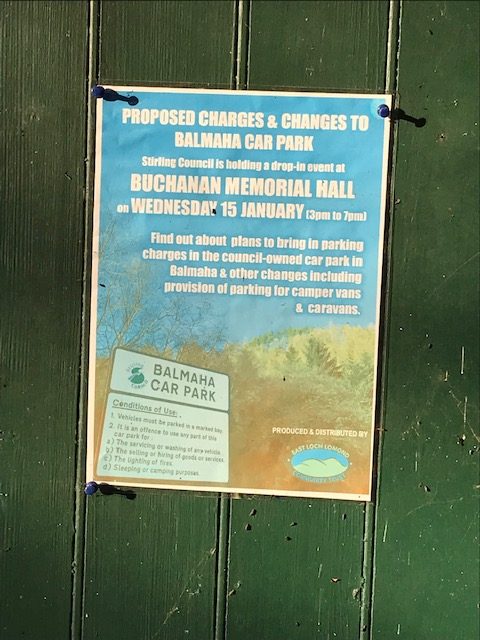
The neglect is not just due to Covid. The meeting was a year ago, 15th January 2020.
The question the LLTNPA Board should ask themselves is why none of their staff or those of Forest and Land Scotland staff who visit the Rowardennan car park haven’t thought to remove this notice?
The answer, I suspect is that good people, who once were committed to working in a National Park, have become hopelessly demoralised. You might be too, if what I hear is true. Almost every suggestion made by frontline staff about how they could better support the public to enjoy the countryside is routinely rebuffed by management.
Sadly there appears to be sadly no leadership in the LLTNPA, no will to serve the public or to support staff, only spin. The reality, as the examples in this post shows, is the LLTNPA is failing even to make good use of the assets they do own. Since the excellent “starter paper” in December 2018, from Jaki Carnegie who has since left the Park Authority, there has been no attempt by the Board – in public at least – to consider whether the LLTNPA is making good use of its assets
This is not a problem unique to the LLTNPA. In Glasgow the public toilets in Pollok Park, one of the most popular places in the city for people to go for a walk, have now been closed for over six months. Cuts in basic outdoor recreation infrastructure have been driven austerity and a general reluctance by our politicians to speak out against this or advocate the necessary investment. While Fergus Ewing, the Rural Economy Secretary, can countenance subsidising the funicular at Cairngorm with tens of millions of pounds (see here), we have to ask why outdoor recreation – and I include downhill skiing in that – gets buttons and public assets continue to be run down?

This article was quite thought provoking and raises the wider issue about whether local authorities and National Parks are really there to help facilitate outdoor recreation when we need them to do this more than ever. Plans should be being put in place now to deal with the inevitable rush to the hills and lochs once restrictions are lifted. Otherwise we will be in the same situation with the same arguments and vilifications when restrictions were lifted last time (and I know some in NPs who think the rebound effect of lifting restrictions will be much more challenging this time around – I agree with them). Mountaineering Scotland have raised the issue of access inequality for those living in urban areas. Residents of Glasgow and Edinburgh are in better positions than some of the cities in northern England which with the exception of Sheffield have pretty poor green space provision by comparison with their European cousins. The lack of access to good outdoor green space may well result in changes in the relationship between urban and rural areas with many people asking what are our cities for ? We don’t have to work here and we don’t have to shop here, so why are we living here? This will likely drive further moves to the countryside from towns. It seems that some of the calls last year from rural communities to restrict visitors from urban areas are resulting in a renewed thirst for much resented second homes in those very communities. The pandemic could well result in significant changes in how we use our towns and countryside. Governments should be thinking about these issues now but sadly, I doubt they are.
The remarks above (and general gist of the blog in general) are why I’m 100% against a new National Park near me, in the Galloway Forest. National Parks don’t appear to do anything for those who frequent them, hinder the local businesses, and seem to think of garish ideas to ‘improve them’ – which don’t. They don’t need the stewardship of a group of people who only add to bureuacracy with their rules and regulations and all the while taking their skim out the public purse.
We’ve got enough people telling us what to do.